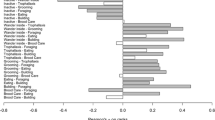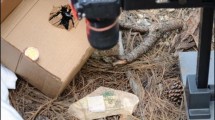Abstract
Ant colonies are often considered to be highly efficient societies skilled at cooperating and sharing workload among workers. Yet, several studies have revealed low colony activity levels and a subgroup of specialized inactive individuals, raising questions about their role. This study investigates whether these inactive ants differ in their sensitivity to environmental cues compared to other worker groups. We monitored the behavior of individually tagged workers from Myrmica rubra ant colonies, categorizing them as foragers, nurses, domestics, or inactives. Approximately one-third of the workers exhibited high levels of inactivity, forming a distinct group that remains stable over several days. Subsequently, individual tests were conducted on these ants to compare their responses to intranidal or extranidal location cues, and to task-related stimuli such as larvae or prey. In individual tests, foragers displayed distinct responses compared to internal workers. They exhibited greater responsiveness to prey, but were less inclined to care for larvae, stay in colony-marked or shaded areas, or approach nestmates. Among internal workers, except for the inactive ants, responses to various stimuli did not significantly differ. Notably, inactives had a stronger attraction to colony odor and were more likely to carry larvae when compared to foragers. Our results suggest that the inactivity of some individuals is not due to a lack of sensitivity to surrounding stimuli. Furthermore, their high propensity to interact with larvae supports the hypothesis of a “reserve caste” function, where these workers become active during periods of increased colony workload.










Similar content being viewed by others
Data availability
The datasets generated and analyzed in this study are available in the Zenodo repository, https://doi.org/https://doi.org/10.5281/zenodo.8389599.
References
Abraham M, Pasteels JM (1980) Social behaviour during nest-moving in the ant Myrmica rubra L. (Hym. Form.). Insectes Soc 27:127–147. https://doi.org/10.1007/BF02229249
Behmer ST (2009) Animal behaviour: feeding the superorganism. Curr Biol 19:R366–R368. https://doi.org/10.1016/j.cub.2009.03.033
Beshers SN, Fewell JH (2001) Models of division of labor in social insects. Annu Rev Entomol 46:413–440
Beverly BD, McLendon H, Nacu S et al (2009) How site fidelity leads to individual differences in the foraging activity of harvester ants. Behav Ecol 20:633–638. https://doi.org/10.1093/beheco/arp041
Blanchard GB, Orledge GM, Reynolds SE, Franks NR (2000) Division of labour and seasonality in the ant Leptothorax albipennis: worker corpulence and its influence on behaviour. Anim Behav 59:723–738. https://doi.org/10.1006/anbe.1999.1374
Breed MD, Williams DB, Queral A (2002) Demand for task performance and workforce replacement: undertakers in honeybee, Apis mellifera, colonies. J Insect Behav 15:319
Brian MV, Abbott A (1977) The control of food flow in a society of the ant Myrmica rubra L. Anim Behav 25:1047–1055
Brown JJ, Traniello JFA (1998) Regulation of brood-care behavior in the dimorphic castes of the ant Pheidole morrisi (Hymenoptera: Formicidae): effects of caste ratio, colony size, and colony needs. J Insect Behav 11:209
Charbonneau D, Dornhaus A (2015a) Workers ‘specialized’ on inactivity: behavioral consistency of inactive workers and their role in task allocation. Behav Ecol Sociobiol 69:1459–1472. https://doi.org/10.1007/s00265-015-1958-1
Charbonneau D, Dornhaus A (2015b) When doing nothing is something. How task allocation strategies compromise between flexibility, efficiency, and inactive agents. J Bioecon 17:217–242. https://doi.org/10.1007/s10818-015-9205-4
Charbonneau D, Hillis N, Dornhaus A (2015) Lazy in nature: ant colony time budgets show high inactivity in the field as well as in the lab. Insectes Soc 62:31–35. https://doi.org/10.1007/s00040-014-0370-6
Charbonneau D, Poff C, Nguyen H et al (2017a) Who are the “lazy” ants? The function of inactivity in social insects and a possible role of constraint: inactive ants are corpulent and may be young and/or selfish. Integr Comp Biol 57:649–667. https://doi.org/10.1093/icb/icx029
Charbonneau D, Sasaki T, Dornhaus A (2017b) Who needs ‘lazy’ workers? Inactive workers act as a ‘reserve’ labor force replacing active workers, but inactive workers are not replaced when they are removed. PLoS ONE 12:e0184074. https://doi.org/10.5061/dryad.77110
Cole BJ (1986) The social behavior of Leptothorax allardycei (Hymenoptera, Formicidae): time budgets and the evolution of worker reproduction. Behav Ecol Sociobiol 18:165–173. https://doi.org/10.1007/BF00290820
Corbara B, Lachaud J-P, Fresneau D (1989) Individual variability, social structure and division of labour in the Ponerine ant Ectatomma ruidum Roger (Hymenoptera, Formicidae). Ethology 82:89–100
Detrain C, Pasteels JM (1992) Caste polyethism and collective defense in the ant, Pheidole pallidula: the outcome of quantitative differences in recruitment. Behav Ecol Sociobiol 29:405–412
Detrain C, Prieur J (2014) Sensitivity and feeding efficiency of the black garden ant Lasius niger to sugar resources. J Insect Physiol 64:74–80. https://doi.org/10.1016/j.jinsphys.2014.03.010
Detrain C, Pereira H, Fourcassié V (2019) Differential responses to chemical cues correlate with task performance in ant foragers. Behav Ecol Sociobiol 73:1–11. https://doi.org/10.1007/s00265-019-2717-5
Dornhaus A, Holley JA, Pook VG et al (2008) Why do not all workers work? Colony size and workload during emigrations in the ant Temnothorax albipennis. Behav Ecol Sociobiol 63:43–51. https://doi.org/10.1007/s00265-008-0634-0
Dussutour A, Simpson SJ (2009) Communal nutrition in ants. Curr Biol 19:740–744. https://doi.org/10.1016/j.cub.2009.03.015
Falibene A, Josens R (2012) Sucrose acceptance threshold: a way to measure sugar perception in ants. Insectes Soc 59:75–80. https://doi.org/10.1007/s00040-011-0190-x
Fresneau D (1984) Développement ovarien et statut social chez une fourmi primitive Neoponera obscuricornis Emery (Hym. Formicidae, Ponerinae). Insectes Soc 31:387–402. https://doi.org/10.1007/BF02223655
Fresneau D, Dupuy P (1988) A study of polyethism in a ponerine ant: Neoponera apicalis (Hymenoptera, formicidae). Anim Behav 36:1389–1399. https://doi.org/10.1016/S0003-3472(88)80209-4
Gadagkar R, Joshi NV (1984) Social organisation in the Indian wasp Ropalidia cyathiformis (Fab.) (Hymenoptera: Vespidae). Z Tierpsychol 64:15–32. https://doi.org/10.1111/j.1439-0310.1984.tb00350.x
Gardner KE, Foster RL, O’Donnell S (2007) Experimental analysis of worker division of labor in bumblebee nest thermoregulation (Bombus huntii, Hymenoptera: Apidae). Behav Ecol Sociobiol 61:783–7927
Hendricks JC, Finn SM, Panckeri KA et al (2000) Rest in Drosophila is a sleep-like state. Neuron 25:129–138
Herbers JM, Cunningham M (1983) Social organization in Leptothorax longispinosus Mayr. Anim Behav 31:759–771. https://doi.org/10.1016/S0003-3472(83)80233-4
Hölldobler B, Wilson EO (1990) The ants. Harvard University Press
Howard DF, Tschinkel WR (1980) The effect of colony size and starvation on food flow in the fire ant, Solenopsis invicta (Hymenoptera: Formicidae). Behav Ecol Sociobiol 7:293–300. https://doi.org/10.1007/BF00300670
Huber R, Hill SL, Holladay C et al (2004) Sleep homeostasis in Drosophila melanogaster. Sleep 27:628–639
Ishii Y, Hasegawa E (2013) The mechanism underlying the regulation of work-related behaviors in the monomorphic ant, Myrmica kotokui. J Ethol 31:61–69. https://doi.org/10.1007/s10164-012-0349-6
Jandt JM, Dornhaus A (2011) Competition and cooperation: Bumblebee spatial organization and division of labor may affect worker reproduction late in life. Behav Ecol Sociobiol 65:2341–2349. https://doi.org/10.1007/s00265-011-1244-9
Jandt JM, Robins NS, Moore RE, Dornhaus A (2012) Individual bumblebees vary in response to disturbance: a test of the defensive reserve hypothesis. Insectes Soc 59:313–321. https://doi.org/10.1007/s00040-012-0222-1
Jeanson R (2019) Within-individual behavioural variability and division of labour in social insects. J Exp Biol 222:jeb190868
Jeanson R, Weidenmüller A (2014) Interindividual variability in social insects - proximate causes and ultimate consequences. Biol Rev 89:671–687. https://doi.org/10.1111/brv.12074
Kaiser W (1995) Rest at night in some solitary bees-a comparison with the sleep-like state of honey bees. Apidologie 26:213–230
Klein BA, Klein A, Wray MK (2010) Sleep deprivation impairs precision of waggle dance signaling in honey bees. PNAS 107:22705–22709. https://doi.org/10.1073/pnas
Leitner N, Dornhaus A (2019) Dynamic task allocation: how and why do social insect workers take on new tasks? Anim Behav 158:47–63. https://doi.org/10.1016/j.anbehav.2019.09.021
Leitner N, Charbonneau D, Gronenberg W, Dornhaus A (2019a) Peripheral sensory organs vary among ant workers but variation does not predict division of labor. Behav Processes 158:137–143. https://doi.org/10.1016/j.beproc.2018.10.016
Leitner N, Lynch C, Dornhaus A (2019b) Ants in isolation: obstacles to testing worker responses to task stimuli outside of the colony context. Insectes Soc 66:343–354. https://doi.org/10.1007/s00040-019-00692-1
Maistrello L, Sbrenna G (1999) Behavioural differences between male and female replacement reproductives in Kalotermes flavicollis (Isoptera, Kalotermitidae). Insectes Soc 46:186–191
Mirenda JT, Vinson SB (1981) Division of labour and specification of castes in the red imported fire ant Solenopsis invicta buren. Anim Behav 29:410–420. https://doi.org/10.1016/S0003-3472(81)80100-5
Moore D (2001) Honey bee circadian clocks: behavioral control from individual workers to whole-colony rhythms. J Insect Physiol 47:843–857
Moore D, Angel JE, Cheeseman IM et al (1998) Timekeeping in the honey bee colony: integration of circadian rhythms and division of labor. Behav Ecol Sociobiol 43:147–160. https://doi.org/10.1007/s002650050476
Nielsen MG (2001) Energetic cost of foraging in the ant Rhytidoponera aurata in tropical Australia. Physiol Entomol 26:248–253. https://doi.org/10.1046/j.0307-6962.2001.00242.x
O’Donnell S (1998) Effects of experimental forager removals on division of labour in the primitively eusocial wasp Polistes instabilis (Hymenoptera: Vespidae). Behaviour 135:173–193. https://doi.org/10.1163/156853998793066348
O’Donnell S, Bulova SJ (2007) Worker connectivity: a review of the design of worker communication systems and their effects on task performance in insect societies. Insectes Soc 54:203–210. https://doi.org/10.1007/s00040-007-0945-6
Page RE, Erber J, Fondrk MK (1998) The effect of genotype on response thresholds to sucrose and foraging behavior of honey bees (Apis mellifera L.). J Comp Physiol 182:489–500. https://doi.org/10.1007/s003590050196
Pamminger T, Foitzik S, Kaufmann KC et al (2014) Worker personality and its association with spatially structured division of labor. PLoS ONE 9:1–8. https://doi.org/10.1371/journal.pone.0079616
Pinter-Wollman N, Hubler J, Holley JA et al (2012) How is activity distributed among and within tasks in Temnothorax ants? Behav Ecol Sociobiol 66:1407–1420. https://doi.org/10.1007/s00265-012-1396-2
Retana J, Cerdá X (1990) Social organization of Cataglyphis cursor ant colonies (Hymenoptera, Formicidae): Inter-, and intraspecific comparisons. Ethology 84:105–122. https://doi.org/10.1111/j.1439-0310.1990.tb00788.x
Robinson EJH, Richardson TO, Sendova-Franks AB et al (2009) Radio tagging reveals the roles of corpulence, experience and social information in ant decision making. Behav Ecol Sociobiol 63:627–636. https://doi.org/10.1007/s00265-008-0696-z
Robson SK, Traniello JFA (1999) Key individuals and the organisation of labor in ants. In: Detrain C, Deneubourg JL, Pasteels JM (eds) Birkhäuser Basel, Basel, pp 239–259
Shaw PJ, Cirelli C, Greenspan RJ, Tononi G (2000) Correlates of sleep and waking in Drosophila melanogaster. Science 287:1834–1837
Sorenşen AA, Mirenda JT, Vinson SB (1981) Food exchange and distribution by three functional worker groups of the imported fire ant Solenopsis invicta Buren. Insectes Soc 28:383–394. https://doi.org/10.1007/BF02224195
Stroeymeyt N, Casillas-Pérez B, Cremer S (2014) Organisational immunity in social insects. Curr Opin Insect Sci 5:1–15. https://doi.org/10.1016/j.cois.2014.09.001
Tobler I (1983) Effect of forced locomotion on the rest-activity cycle of the cockroach. Behav Brain Res 8:351–360
Acknowledgements
We would like to thank Luc Dekelver for helping us collect ants in the field. We thank the FRIA “Fonds pour la formation à la recherche dans l’industrie et dans l’agriculture” for funding this research with the grant n°1.E.106.19F awarded to the author O.V.
Funding
Fonds pour la Formation à la Recherche dans l’Industrie et dans l’Agriculture, 1.E.106.19F, Oscar Vaes.
Author information
Authors and Affiliations
Contributions
All authors contributed to the conceptualization and the methodology of the experiment, the formal analysis, and the investigation of data. Writing the original draft and the acquisition of funding were done by Oscar Vaes and Claire Detrain. Oscar Vaes and Quentin Avanzi performed the visualization and the curation of data. Software manipulation and the administration of the project were done by Oscar Vaes. Reviewing and editing the manuscript, supervision and validation of the work as well as providing the resources were done by Claire Detrain.
Corresponding author
Ethics declarations
Conflict of interest
The authors have no competing interests to declare that are relevant to the content of this article.
Supplementary Information
Below is the link to the electronic supplementary material.
Rights and permissions
Springer Nature or its licensor (e.g. a society or other partner) holds exclusive rights to this article under a publishing agreement with the author(s) or other rightsholder(s); author self-archiving of the accepted manuscript version of this article is solely governed by the terms of such publishing agreement and applicable law.
About this article
Cite this article
Vaes, O., Avanzi, Q. & Detrain, C. Beyond busy workers: exploring the sensitivity of inactive ants to environmental cues. Insect. Soc. (2024). https://doi.org/10.1007/s00040-024-00959-2
Received:
Revised:
Accepted:
Published:
DOI: https://doi.org/10.1007/s00040-024-00959-2




